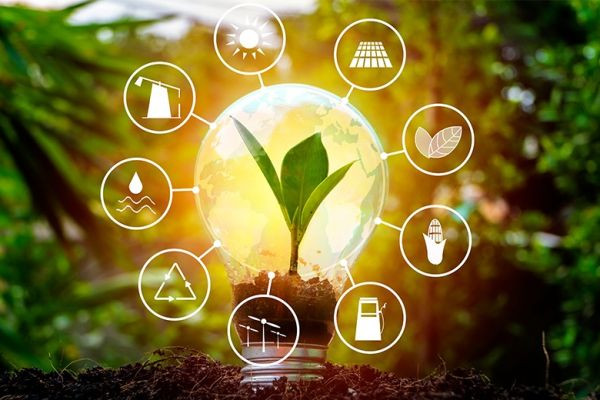Introduction:
With rising energy costs and growing concerns about the environment, finding ways to reduce energy consumption at home is essential. By making small changes and adopting energy-efficient practices, you can not only save money but also contribute to a sustainable future. This article provides practical tips to help you lower your energy costs and reduce your carbon footprint.
Upgrade to Energy-Efficient Appliances:
Replace old, inefficient appliances with energy-efficient models. Look for appliances with an ENERGY STAR label, as they consume less energy without compromising performance. Focus on high-energy-consuming devices like refrigerators, air conditioners, water heaters, and washing machines.
Reducing energy costs becomes a breeze with the adoption of eco-friendly tips such as upgrading to energy-efficient appliances. These modern marvels not only enhance the functionality of your home but also align with sustainable living practices. When choosing new appliances, prioritize those with advanced energy-saving features, such as programmable timers, motion sensors, and power-saving modes. Additionally, opt for appliances that operate on renewable energy sources like solar power or those that utilize efficient technologies like heat pumps. By making these environmentally conscious choices, you not only lower your energy costs but also make a positive impact on the environment, fostering a greener and more sustainable home.
Efficient Lighting Solutions:
Switch to energy-efficient light bulbs such as LED or CFL bulbs. They use less energy and last longer than traditional incandescent bulbs. Additionally, remember to turn off lights when not in use and make the most of natural daylight.
Lowering energy costs and achieving sustainable living is within reach through the adoption of efficient lighting solutions. By transitioning to energy-saving LED lights, you can witness a significant reduction in electricity consumption while enjoying a longer lifespan for your lighting fixtures. These green alternatives not only minimize energy waste but also emit fewer greenhouse gases, contributing to a healthier environment. To maximize the benefits, incorporate natural lighting strategies by utilizing natural sunlight during the day through the placement of windows, skylights, or solar tubes. Additionally, consider installing motion sensors or timers to automatically switch off lights when they're not in use, further optimizing your energy usage. With these eco-friendly tips, you can illuminate your home while embracing a greener, more sustainable lifestyle.
Unplug Electronics and Use Power Strips:
Many electronics and appliances consume energy even when not in use. Unplug devices or use power strips with an on/off switch to easily cut power to multiple devices at once. This practice eliminates "vampire" energy usage and reduces your electricity bill.
Implementing the use of power strips in your home is a smart and practical way to achieve energy savings and promote a green home. Power strips not only provide a centralized location for plugging in multiple electronics but also offer the added advantage of surge protection. This ensures that your devices are safeguarded against power surges, prolonging their lifespan. By utilizing power strips, you can easily turn off multiple devices with a single switch, preventing phantom energy consumption and reducing unnecessary energy usage. Remember to opt for energy-saving power strips that are ENERGY STAR certified, as they are designed to maximize energy efficiency. Incorporating this eco-friendly tip into your daily routine will not only help lower energy costs but also contribute to a sustainable and environmentally conscious lifestyle.
Optimize Heating and Cooling:
Set your thermostat to an energy-efficient temperature and consider installing a programmable thermostat to adjust temperatures automatically. Properly insulate your home, seal air leaks, and keep windows and doors well-insulated to prevent heat or cool air from escaping.
Embracing eco-friendly tips for optimizing heating and cooling not only benefits the environment but also contributes to lower energy costs in your home. Consider natural heating techniques, such as maximizing sunlight by keeping curtains open during the day and closing them at night to retain warmth. When it comes to cooling, make use of natural ventilation by opening windows and using ceiling fans to create a refreshing breeze. Another effective strategy is to shade your windows with energy-efficient blinds or curtains to reduce heat gain from the sun. Additionally, investing in energy-efficient heating and cooling equipment, such as ENERGY STAR certified appliances, can provide substantial energy savings. By incorporating these sustainable living practices and prioritizing green home solutions, you can optimize your heating and cooling systems for improved energy efficiency, lower energy costs, and a more environmentally friendly home.
Efficient Water Usage:
Reduce water heating costs by taking shorter showers, fixing leaky faucets promptly, and using low-flow showerheads and faucets. Insulate your water heater and set its temperature to an appropriate level (120°F or 49°C) to save energy.
When it comes to efficient water usage, it's essential to be mindful of how we manage our water consumption. A green home promotes sustainable living by incorporating eco-friendly tips that encourage responsible water usage. One effective way to lower energy costs associated with water usage is by collecting and reusing rainwater. Installing a rainwater harvesting system allows you to harness nature's gift and utilize it for various non-potable purposes such as watering plants and flushing toilets. Additionally, landscaping choices can also play a role in efficient water usage. Opt for native and drought-resistant plants that require less watering and maintenance, reducing your overall water consumption. Implementing a gray water system can also contribute to energy savings and sustainable living by reusing water from activities such as washing dishes or doing laundry for purposes like irrigation. By implementing these eco-friendly strategies and adopting responsible water management practices, you can create a greener, more sustainable home while minimizing your environmental footprint.
Energy-Smart Laundry and Dishwashing:
Wash clothes in cold water whenever possible, as hot water consumes a significant amount of energy. Wait for a full load before running the dishwasher or washing machine. Air dry clothes instead of using a dryer, and clean dryer lint filters after each use to improve efficiency.
Incorporate energy-saving strategies into your daily laundry and dishwashing routines, transforming your home into an energy-efficient haven while enjoying the benefits of lower energy costs. Sustainable living starts with conscious decision-making, and small changes can make a big difference. Choose environmentally friendly detergents and dishwasher soaps that are biodegradable and free from harmful chemicals, promoting a greener home environment. By utilizing the delay start feature on your appliances, you can take advantage of off-peak energy hours, optimizing energy savings. Additionally, practicing proper maintenance, such as regularly cleaning the lint filter in your dryer or keeping dishwasher filters clean, ensures optimal performance and energy efficiency. Implementing these eco-friendly tips and tricks not only contributes to a sustainable lifestyle but also allows you to save money while reducing your ecological impact. Embrace the power of energy-smart laundry and dishwashing and join the movement towards a greener, more eco-conscious future.
Use Natural Ventilation and Fans:
In temperate weather, open windows and use natural ventilation to cool your home instead of relying solely on air conditioning. Use ceiling fans or portable fans to circulate air, which can help you feel cooler without drastically lowering the thermostat.
As part of your eco-friendly tips for a sustainable lifestyle, prioritize the use of natural ventilation and fans to achieve lower energy costs and foster a green home environment. Open up windows strategically to take advantage of cross ventilation, allowing fresh air to flow freely and cool your living spaces naturally. Additionally, consider installing ceiling fans or portable fans in rooms to enhance air circulation and promote a comfortable atmosphere. By relying on these energy-efficient alternatives to air conditioning, you'll not only reduce your carbon footprint but also experience significant savings on your energy bills. Embracing natural ventilation and fans as integral components of your sustainable living practices will contribute to a greener home and a brighter future for our plane
Renewable Energy Sources:
Consider investing in renewable energy sources like solar panels or wind turbines. While the upfront costs may be higher, these systems can significantly reduce your reliance on grid power and provide long-term energy savings.
Incorporating renewable energy sources into your home not only aligns with sustainable living principles but also paves the way for a greener future. Lowering energy costs becomes attainable through eco-friendly tips that optimize renewable resources. Implementing energy-efficient appliances, such as energy-star rated products, can minimize electricity consumption and support green home initiatives. Additionally, investing in insulation and sealing gaps in your home can improve energy efficiency by preventing heat loss during winter months. By adopting these eco-friendly practices, you can enjoy the benefits of lower energy costs while reducing your carbon footprint. Embrace the power of renewable energy sources and make a positive impact on the environment while leading the way toward a more sustainable and energy-efficient lifestyle.
Energy Audit and Home Insulation:
Schedule a professional energy audit to identify areas where your home may be losing energy. Proper insulation, weatherstripping, and sealing gaps can improve energy efficiency and reduce heating and cooling costs.
Home insulation plays a vital role in maintaining a green home and achieving energy savings. By properly insulating your home, you can minimize heat transfer, improve energy efficiency, and reduce the need for excessive heating or cooling. Our article delves into the importance of home insulation and provides eco-friendly tips for optimizing insulation levels. Learn about different insulation materials and techniques, from fiberglass to spray foam, and discover which options align with your sustainable living goals. By investing in proper insulation, you not only lower energy costs but also contribute to environmental conservation. Create a comfortable living space while reducing your carbon footprint by incorporating effective insulation strategies into your green home initiatives.
Educate and Involve the Family:
Encourage your family members to adopt energy-saving habits. Teach them the importance of turning off lights, unplugging devices, and conserving energy. Engage in energy-saving activities together, such as organizing a "lights-out" evening or implementing a weekly energy challenge.
Creating a culture of sustainable living starts with engaging the entire family in eco-friendly practices. Foster a sense of responsibility and environmental consciousness by involving everyone in daily energy-saving routines. Encourage the use of energy-efficient appliances and devices, such as LED light bulbs and smart thermostats, which can significantly lower energy costs. Teach children about the importance of recycling, composting, and reducing waste, instilling values of environmental stewardship early on. Plan fun activities that promote sustainable living, such as gardening, where the family can grow their own organic produce and reduce their carbon footprint. By educating and involving the family in green initiatives, you not only promote energy savings but also create a sustainable home environment that nurtures a greener future for generations to come.
Conclusion:
Reducing energy costs and consumption at home is achievable through simple lifestyle changes and energy-efficient practices. By upgrading appliances, optimizing heating and cooling, using efficient lighting, and adopting water-saving habits, you can make a significant impact on both your energy bills and the environment. Remember, every small step counts, so start implementing these tips today and be a responsible energy consumer for a sustainable future.
 Bitcoin: $97783.86 1.21%
Bitcoin: $97783.86 1.21%  Ethereum: $3414.62 3.03%
Ethereum: $3414.62 3.03%  Tether: $1.00 0.02%
Tether: $1.00 0.02%  Solana: $256.36 0.25%
Solana: $256.36 0.25%  BNB: $658.40 5.34%
BNB: $658.40 5.34%  XRP: $1.47 0.36%
XRP: $1.47 0.36%  Dogecoin: $0.43 5.76%
Dogecoin: $0.43 5.76%  USDC: $1.00 0.04%
USDC: $1.00 0.04%  Cardano: $1.06 9.67%
Cardano: $1.06 9.67%  Lido Staked ETH: $3396.49 3.2%
Lido Staked ETH: $3396.49 3.2%  TRON: $0.21 7.17%
TRON: $0.21 7.17%  Avalanche: $42.26 6.62%
Avalanche: $42.26 6.62%  Stellar: $0.51 69.68%
Stellar: $0.51 69.68%  Shiba Inu: $0.00 3.42%
Shiba Inu: $0.00 3.42%  Wrapped Bitcoin: $97430.70 1.3%
Wrapped Bitcoin: $97430.70 1.3%  Polkadot: $8.55 35.74%
Polkadot: $8.55 35.74%  Chainlink: $17.63 11.95%
Chainlink: $17.63 11.95%  Bitcoin Cash: $509.28 4.11%
Bitcoin Cash: $509.28 4.11%  UNUS SED LEO: $8.61 1.28%
UNUS SED LEO: $8.61 1.28%  NEAR Protocol: $6.25 10.37%
NEAR Protocol: $6.25 10.37%  Litecoin: $98.78 9.22%
Litecoin: $98.78 9.22%  Uniswap: $10.87 14.4%
Uniswap: $10.87 14.4%  Internet Computer: $11.33 12.99%
Internet Computer: $11.33 12.99%  Multi Collateral DAI: $1.00 0.02%
Multi Collateral DAI: $1.00 0.02%  Crypto.com Coin: $0.19 2.96%
Crypto.com Coin: $0.19 2.96%  Sp8de: $0.59 12.83%
Sp8de: $0.59 12.83%  Ethereum Classic: $29.84 6.47%
Ethereum Classic: $29.84 6.47%  Artificial Superintelligence Alliance: $1.39 11.93%
Artificial Superintelligence Alliance: $1.39 11.93%  VeChain: $0.04 29.62%
VeChain: $0.04 29.62%  Filecoin: $5.38 14.19%
Filecoin: $5.38 14.19%  Stacks: $2.11 7.59%
Stacks: $2.11 7.59%  OKB: $50.62 9.97%
OKB: $50.62 9.97%  Monero: $160.42 0.97%
Monero: $160.42 0.97%  Aave: $176.73 7.2%
Aave: $176.73 7.2%  Algorand: $0.30 24.69%
Algorand: $0.30 24.69%  Fantom: $0.89 22.85%
Fantom: $0.89 22.85%  The Graph: $0.24 13.06%
The Graph: $0.24 13.06%  Hedera Hashgraph: $0.15 12.26%
Hedera Hashgraph: $0.15 12.26%  Injective: $28.16 14.98%
Injective: $28.16 14.98%  Cosmos: $8.23 12.74%
Cosmos: $8.23 12.74%  THORChain: $5.69 7.65%
THORChain: $5.69 7.65%  THETA: $1.91 13.13%
THETA: $1.91 13.13%  MANTRA DAO: $3.67 0.24%
MANTRA DAO: $3.67 0.24%  Raydium: $6.03 0.21%
Raydium: $6.03 0.21%  Maker: $1655.76 0.76%
Maker: $1655.76 0.76%  Arweave: $22.28 26.76%
Arweave: $22.28 26.76%  Bitcoin SV: $71.10 5.12%
Bitcoin SV: $71.10 5.12%  KuCoin Token: $11.49 3.61%
KuCoin Token: $11.49 3.61%  Polygon: $0.57 21.99%
Polygon: $0.57 21.99%  Flow: $0.84 16.07%
Flow: $0.84 16.07%  Quant: $102.25 19.06%
Quant: $102.25 19.06%  Gala: $0.03 17.13%
Gala: $0.03 17.13%  Lido DAO: $1.34 8.97%
Lido DAO: $1.34 8.97%  EOS: $0.77 8.48%
EOS: $0.77 8.48%  Tezos: $1.15 3.74%
Tezos: $1.15 3.74%  Neo: $14.67 10.23%
Neo: $14.67 10.23%  Axie Infinity: $6.71 13.59%
Axie Infinity: $6.71 13.59%  Helium: $5.85 7.03%
Helium: $5.85 7.03%  Decentraland: $0.51 19.82%
Decentraland: $0.51 19.82%  The Sandbox: $0.42 16.18%
The Sandbox: $0.42 16.18%  Akash Network: $3.96 6.11%
Akash Network: $3.96 6.11%  GateToken: $11.03 9.03%
GateToken: $11.03 9.03%  AIOZ Network: $0.82 12.51%
AIOZ Network: $0.82 12.51%  eCash: $0.00 3.87%
eCash: $0.00 3.87%  Pendle: $5.35 6.47%
Pendle: $5.35 6.47%  Nexo: $1.35 3.05%
Nexo: $1.35 3.05%  MultiversX: $35.89 18.22%
MultiversX: $35.89 18.22%  Mina: $0.72 7.8%
Mina: $0.72 7.8%  FTX Token: $2.51 4.55%
FTX Token: $2.51 4.55%  Conflux: $0.17 11.51%
Conflux: $0.17 11.51%  Zcash: $48.10 5.92%
Zcash: $48.10 5.92%  Chiliz: $0.09 12.08%
Chiliz: $0.09 12.08%  IOTA: $0.22 20.5%
IOTA: $0.22 20.5%  Gnosis: $273.88 5.04%
Gnosis: $273.88 5.04%  Oasis: $0.10 15.88%
Oasis: $0.10 15.88%  XinFin Network: $0.05 17.83%
XinFin Network: $0.05 17.83%  SuperVerse: $1.33 8.85%
SuperVerse: $1.33 8.85%  PancakeSwap: $2.19 12.12%
PancakeSwap: $2.19 12.12%  Nervos Network: $0.01 7.67%
Nervos Network: $0.01 7.67%  Curve DAO Token: $0.50 12.08%
Curve DAO Token: $0.50 12.08%  Kusama: $39.49 82.6%
Kusama: $39.49 82.6%  Compound: $64.47 19.23%
Compound: $64.47 19.23%  Kava: $0.49 8.05%
Kava: $0.49 8.05%  TrueUSD: $1.00 0%
TrueUSD: $1.00 0%  DeXe: $8.44 1.14%
DeXe: $8.44 1.14%  Theta Fuel: $0.07 6.24%
Theta Fuel: $0.07 6.24%  NXM: $72.15 3.41%
NXM: $72.15 3.41%  Zilliqa: $0.02 15.98%
Zilliqa: $0.02 15.98%  1inch Network: $0.37 7.54%
1inch Network: $0.37 7.54%  Synthetix: $2.00 10.87%
Synthetix: $2.00 10.87%  WOO: $0.24 11.97%
WOO: $0.24 11.97%  Celo: $0.81 12.4%
Celo: $0.81 12.4%  Reserve Rights: $0.01 10.7%
Reserve Rights: $0.01 10.7%  Trust Wallet Token: $1.02 5.97%
Trust Wallet Token: $1.02 5.97%  Livepeer: $11.75 12.23%
Livepeer: $11.75 12.23%  IoTeX: $0.04 5.4%
IoTeX: $0.04 5.4%  Enjin Coin: $0.23 15.63%
Enjin Coin: $0.23 15.63%  Holo: $0.00 11.07%
Holo: $0.00 11.07%  Amp: $0.01 7.97%
Amp: $0.01 7.97%  Dash: $33.23 13.41%
Dash: $33.23 13.41% 








